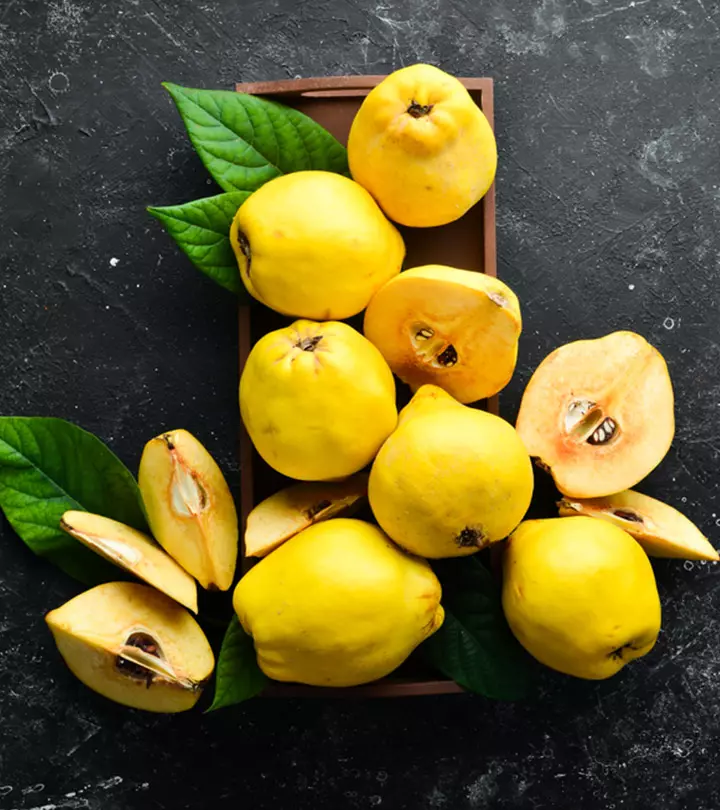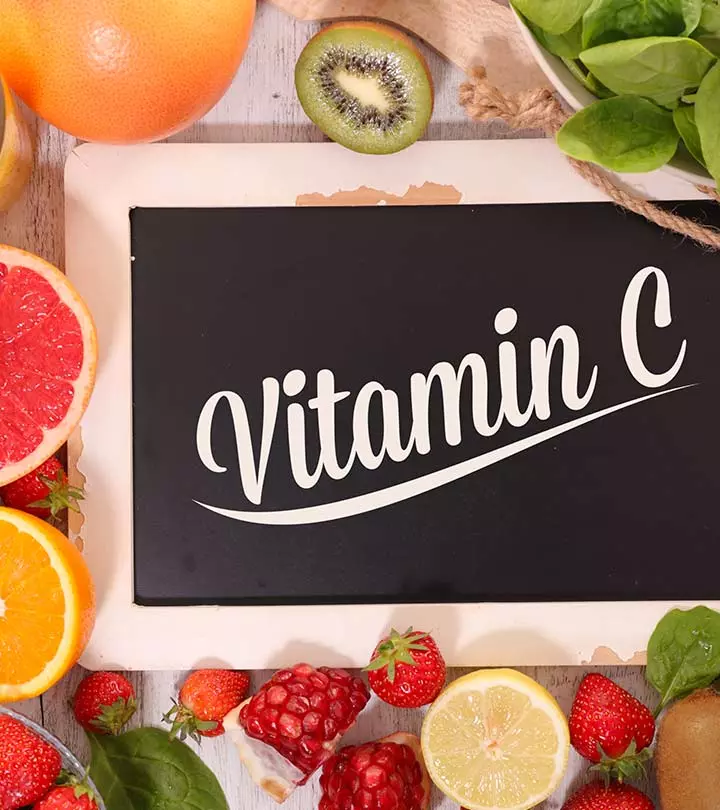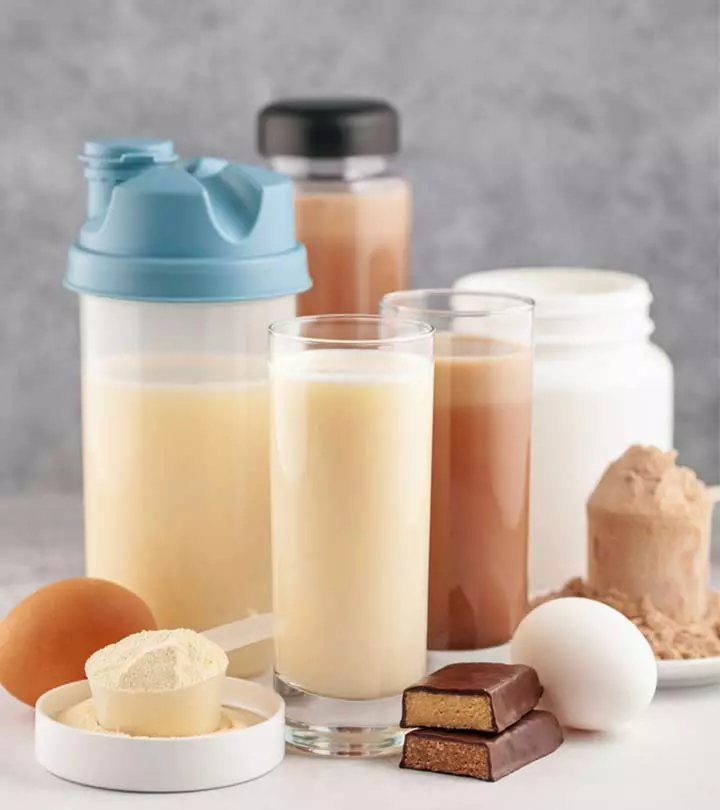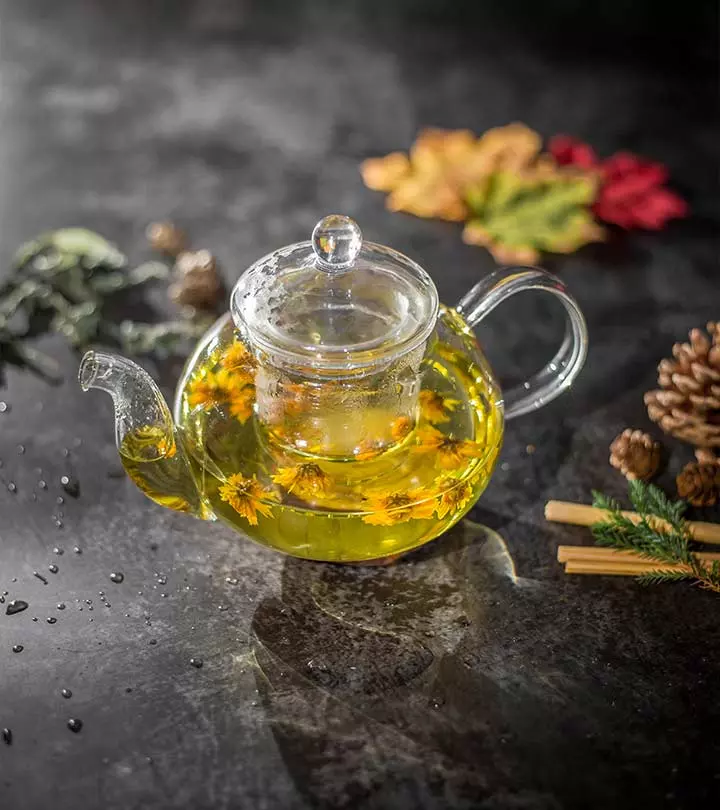8 Amazing Health Benefits Of Quince Fruit You Need To Know
Add this fruit to your diet to protect yourself from cancer and prevent ulcers.

Image: Shutterstock
The quince fruit tastes tart and sour and is bright yellow. It is often described as a cross breed of an apple and a pear. The health benefits of quince fruit can be linked to its dietary fiber, vitamin C, and other antioxidants. This fruit is used to make many processed jams, spirits, and juices. This article explores the health benefits, nutritional content, possible side effects, and recipes of the quince fruit. Keep reading.

In This Article
What Is Quince Fruit And Its History?
Quince (Cydonia oblonga) is a shrub or small tree belonging to the Asian genera and Rosaceae family. This yellow, pear-shaped hairy fruit has a typical flavor and aroma. Raw quince is tough, astringent, and sour.
This plant originated in Asia Minor and spread through the countries bordering the Himalayan mountains to the East and throughout Europe to the West. However, it is most likely that quince did not reach the Mediterranean region until the classical period when it was used by the Romans (1).
 Trivia
TriviaThe ancient civilizations cultivated quince for its medicinal benefits.. Continue reading to discover what gives this fruit its medicinal powers.
Key Takeaways
- Quince is a pear-shaped hair fruit that is astringent, sour, and tough. It contains vitamin C, fiber, and minerals.
- It has antioxidant, antimicrobial, and anti-allergic properties, and it may help treat GERD, stomach ulcers, pregnancy-induced nausea, and cancer.
- This fruit can be eaten raw or cooked to gain its benefits.
- When ingested in excess amounts, it may cause inflammation, skin irritation, diarrhea, and digestion issues.
Nutritional Information Of Quince Fruit
A hundred grams of raw quince contains (2):
Calories | 57 kcal |
Proteins | 0.4 g |
Carbohydrates | 15.3 g |
Total lipids (Fat) | 0.1 g |
Sodium | 4 mg |
Potassium | 197 mg |
Calcium | 11 mg |
Iron | 0.7 mg |
Magnesium | 8 mg |
Phosphorus | 17 mg |
Zinc | 0.04 mg |
Dietary fiber | 1.9 g |
Vitamin C | 15 mg |
Compared to apples, quince contains nearly two times more vitamin C and more minerals (3).
Shena Jaramillo, RD, says, “Quince fruit is a great source of potassium and fiber. Potassium is an important electrolyte in the body, and fiber aids in digestion. It is also a great source of vitamin C, which helps with collagen formation and supports the immune system.” Read on to learn more about the health benefits of quince.
7 Potential Health Benefits of Quince Fruit
1. A Good Source Of Antioxidants
Quince pulp, seeds, and peel are rich in antioxidant phenolic compounds because of their rich vitamin C (ascorbic acid) content (4). The phenolic compounds are crucial for minimizing oxidative stress and inflammation, the main causes of numerous health issues. Moreover, antioxidants also strengthen the immune system to protect the body against harmful pathogens.
2. May Protect Against Stomach Ulcers
A rat study found that the phenolic compounds in Chinese quince extracts could suppress gastric ulcers and keep the gastrointestinal tract healthy (5). The antioxidants can help protect the mucus membrane of the stomach (gastric mucosa) by minimizing harmful inflammation and oxidative stress.
3. Antimicrobial Effects
The phenolic compounds in quince extract (pulp and peel) have antimicrobial properties. They can disrupt bacterial cell membranes and interfere with their metabolism and eliminate them (6).
4. May Help With Pregnancy-Induced Nausea
A trial on pregnant women found that quince syrup could significantly reduce with mild to moderate nausea and vomiting (NVP). Hence, quince is safe to consume by pregnant women and can even be a better alternative to improve symptoms of nausea and vomiting (7).
5. May Have Anti-Allergic Effects
A mice study found that quince extract could relieve the symptoms of a type I allergy (immediate reaction) by suppressing the antibody production and inhibiting the atopic dermatitis-like allergic responses (8).
6. May Help With Gastroesophageal Reflux Disease (GERD)
Research showed that quince fruit extract is as effective as ranitidine in relieving the symptoms of pregnancy-related GERD.
In a 2025 study published in Gastroenterology, findings from the 2015 National Gastrointestinal Survey involving 71,812 participants revealed noteworthy statistics on Gastroesophageal Reflux Disease (GERD). About 44.1% reported having experienced GERD symptoms in the past, while 30.9% experienced them in the previous week. Surprisingly, among those using Proton Pump Inhibitors (PPIs), 54.1% continued to suffer from persistent GERD symptoms.
Quince is traditionally used as a gastric tonic to boost gut health and reduce nausea, vomiting, and other gut-related issues (9).
7. May Prevent Cancer
A study observed that the phenolic compounds in quince fruit and leaf extracts inhibited the proliferation of colon and renal cancer cells. Researchers concluded that quince extracts might be useful in the prevention and treatment of cancer (10). However, more studies are warranted to prove the efficacy of quince extract as a chemopreventive and chemotherapeutic agent.
8. May Help Boost Heart Health
Quince fruit emerges as a promising natural aid for heart health, supported by various studies that highlight its beneficial impacts on cardiovascular markers. Research consistently demonstrates its positive effects on lipid profiles, showcasing significant reductions in total cholesterol (TC), triglycerides (TG), and LDL cholesterol (LDL-C) levels while elevating the beneficial HDL cholesterol (HDL-C). Notably, quince extracts exhibit lipid-lowering effects comparable to standard medications like simvastatin, emphasizing their potential to manage cholesterol levels. Additionally, quince showcases promise in addressing diabetes, stimulating pathways that enhance glucose metabolism. While effects on insulin levels vary, this fruit helps improve glucose control. Moreover, studies reveal quince’s positive influence on blood pressure, demonstrating antihypertensive effects akin to conventional medications like captopril (11).
There are many ways to include quince in your diet. However, if you are new to this fruit, your tastebuds may take time to adapt to its rich and exciting flavor and texture. Some hints on how you can enjoy this delectable fruit are laid out in the following sections.
 Did You Know?
Did You Know?How To Eat Quince Fruit
Quince can be eaten raw or cooked, with or without the skin. However, not everyone may prefer raw quince as it has a sour and astringent taste. Cooked quince has a sweet and floral flavor.
Quince becomes significantly more palatable when cooked because it releases its natural sweetness and changes from a firm texture to a soft, delicious smoothness. It can be used to savory meals for a distinctive flavor contrast, roasted with warm spices like cloves and cinnamon, or poached in sugar syrup. Quince can also be stewed to make a thick jam or compote that goes well with cheese or spreads on toast. Baked quince may also make a delicious filling for tarts and pies.
 Pro Tip
Pro TipThe best way to preserve (and consume) quince is by preparing marmalades, jams, and jellies. You may substitute quince for apples and pears in different recipes like crumbles, cakes, pies, and other desserts. You may also prepare quince vinegar (just like homemade apple cider vinegar) and enjoy this seasonal produce throughout the year. Here are a few popular recipes you can try out.
Popular Recipes Using Quince Fruit
1. Quince Jelly
This lovely rose-colored quince jelly is abundant in natural pectins and healthy nutrients.
What You Need
- 1.5 kg of quince, diced
- 7 cups of water
- 7 cups of sugar
How To Prepare
- Boil the diced quince in water. Lower the heat and simmer for 45 minutes to an hour until the quince pieces are tender.
- Mash the cooked quince until smooth. Add more water if required.
- Strain the mashed quince pulp with cheesecloth and strainer. Collect the pulp.
- Boil the strained quince pulp in a pot with a thick bottom.
- For every cup of juice, add less than a cup of sugar.
- Stir until the sugar dissolves. Measure the temperature with a thermometer.
- Scoop out the foam from the jelly while cooking.
- The jelly will thicken once the temperature rises above 100°C (water’s boiling point). Once the temperature reaches 106°-108°C, the jelly is ready.
- Store the jelly in sterilized glass jars.
2. Quince Pie
The classic apple pie has a delectable autumn flavor. Skip the pie crust and top your pie with sliced quinces and granny apples for a crunchy taste.
What You Need
- 3 cups of peeled quinces, thinly sliced
- 1 can of apple juice, unsweetened
- 1 teaspoon of cloves
- 9-inch pie pastry
- 5 cups of apples, thinly sliced
- ½ cup of sugar
- 3 tablespoons of all-purpose flour
- ½ teaspoon of ground cinnamon
- ¼ teaspoon of salt
- ¼ teaspoon of ground nutmeg
How To Prepare
- Preheat the oven at 375°F.
- Combine the quinces and apple juice in a big pot.
- Make a spice bag with the cloves (put them on a cheesecloth and tie). Toss it into the pan.
- Boil the mixture. Lower the heat, cover, and cook for 12-15 minutes, or until the quinces are crisp-tender.
- Uncover and cook for another 8-12 minutes, or until the liquid has been reduced to 2 tablespoons.
- Discard the spice bag and let it cool down for 5 minutes.
- Line the pie pan with pastry. Trim to half-inch beyond the plate’s edge and flute the edges.
- Combine the apples, sugar, flour, cinnamon, salt, nutmeg, and quince mixture. Pour the mixture into the crust.
- Bake for 50-60 minutes.
3. Quince Glazed Brussels Sprouts
Add a little zest to the classic roasted Brussels sprouts with a sweet and fruity sauce spiced with a hint of fire from crushed red pepper flakes.
What You Need
- 900 g of Brussels sprouts, trimmed and halved
- ¼ cup of olive oil
- 1/3 cup of quince paste
- 1/3 cup of water
- 2 tablespoons of granulated sugar
- 1 teaspoon of grated lemon zest
- 1 tablespoon of lemon juice
- ½ teaspoon of crushed red pepper
- ¼ teaspoon of paprika
- 4 tablespoons of basil, finely chopped
- ¾ teaspoon of salt
- ½ teaspoon of black pepper, freshly ground
How To Prepare
- Preheat a baking sheet in the oven at 400°F for 5 minutes.
- Toss the Brussels sprouts with oil, salt, and pepper and roast them for 20-25 minutes. Flip them once halfway through.
- Mix and simmer quince paste, water, sugar, lemon juice, and crushed red pepper in a small saucepan for five minutes.
- Add paprika, salt, and pepper (as per taste) and remove from heat.
- Toss the roasted Brussels sprouts and quince glaze.
- Garnish with lemon zest and basil.
A food blogger jotted down her heartfelt memories of how her mother prepared quince fruit. She added, “This is my favorite way to eat quince. Baked in the oven, slowly simmering in sweet sugar syrup. A more grown up and sophisticated version of the stewed fruit from my childhood (i).”
Since quince is available during the fall, you may want to store it for later use. Here are a few tips.
How To Store Quince Fruit
, RD, says, “Usually sold unripe in the US, it’ll take a few days on the countertop to ripen your quince. You’ll know it’s unripe if the fruit is more green than yellow, hard (rather than giving to the touch) & has little to no fruity fragrance. Like other fruits, to speed the process, store in a paper bag on the countertop.”
She adds, “Once cut, your quince will oxidize, so wrap tightly with plastic wrap or cover the cut portion of fruit thoroughly with lemon juice (albeit, this will make your quince more tart). Quince tends to absorb the odor of other foods, so it’s important to store away from strong smells whether on the countertop or in the refrigerator.”
According to Jaramillo, quince fruit can be stored for up to two weeks at cool temperatures.
Quince is a healthy and nutritious addition to your diet. However, it has some possible adverse effects worth noting.
Possible Side Effects Of Quince Fruit
MD, shares, “When consumed in large quantities, quince causes negative effects on the stomach (elicits the stomach to produce volatile gases). When exposed to the skin, the fruit causes irritations to the skin. It also causes inflammation (swellings). The fruit is also responsible for causing diarrhea and problems in digestion.”
The benefits of quince fruit can be attributed to its nutrients. If included as a part of the diet, this fruit helps combat oxidative stress and inflammation. In addition, it protects against stomach ulcers, has anti-microbial effects, and helps manage pregnancy-induced nausea. It also exhibits anti-allergic effects and helps manage gastrointestinal reflux disease. Furthermore, the phenolic compounds in this fruit may reduce cancer risk. This fruit can be easily added to your diet. However, if consumed in excess, it may trigger skin irritation and cause digestive issues. Hence, consume it in moderation to reap the benefits.
Frequently Asked Questions
Is quince good for kidneys?
Yes, Quince may exert a protective effect on the kidneys in a number of ways. It may help regulate blood pressure and thus prevent kidney damage associated with hypertension (12), ( 13). In studies, quince extract has been shown to reduce kidney damage associated with high levels of fat in the bloodstream (hyperlipidemia) (14). In addition, it may protect against renal cancer (10).
Is quince alkaline or acidic?
Though quince contains some organic acids, it breaks down in the body as alkaline ash when consumed fresh.
Is quince a citrus fruit?
No, quince is not a citrus fruit. It is instead a pome fruit, much like apples and pears.
Be it for nutrition in jams and marmalade or as any skincare ingredient, quince fruit can help you all the way along. Watch the following video to learn how it helps improve your overall health.
Personal Experience: Source
StyleCraze's articles are interwoven with authentic personal narratives that provide depth and resonance to our content. Below are the sources of the personal accounts referenced in this article.
(i) Quinces And A Celebrationhttps://intolerantchef.blogspot.com/2011/05/quinces-and-celebration.html
References
Articles on StyleCraze are backed by verified information from peer-reviewed and academic research papers, reputed organizations, research institutions, and medical associations to ensure accuracy and relevance. Read our editorial policy to learn more.
- A Review on Quince (Cydonia oblonga): A Useful Medicinal Plant
https://www.researchgate.net/publication/287811528_A_Review_on_Quince_Cydonia_oblonga_A_Useful_Medicinal_Plant - Quinces raw
https://fdc.nal.usda.gov/fdc-app.html#/food-details/168163/nutrients - review of nutritional value and putative health-effects of quince (Cydonia oblonga Mill.) fruit
https://www.researchgate.net/publication/329633335_review_of_nutritional_value_and_putative_health-effects_of_quince_Cydonia_oblonga_Mill_fruit - Quince (Cydonia oblonga Miller) Fruit (Pulp Peel and Seed) and Jam: Antioxidant Activity
https://pubs.acs.org/doi/full/10.1021/jf040057v - Antioxidant and Antiulcerative Properties of Phenolics from Chinese Quince Quince and Apple Fruits
https://pubs.acs.org/doi/abs/10.1021/jf052236y - Antimicrobial Activity of Tunisian Quince (Cydonia oblonga Miller) Pulp and Peel Polyphenolic Extracts
https://pubs.acs.org/doi/abs/10.1021/jf062614e - Comparison of quince with vitamin B6 for treatment of nausea and vomiting in pregnancy: a randomised clinical trial
https://www.tandfonline.com/doi/abs/10.1080/01443615.2017.1322046 - Anti-Allergic Effect of a Hot-Water Extract of Quince (Cydonia oblonga)
https://www.jstage.jst.go.jp/article/bbb/73/8/73_90130/_article/-char/ja/ - A comparative study of ranitidine and quince (Cydonia oblonga mill) sauce on gastroesophageal reflux disease (GERD) in pregnancy: a randomised open-label active-controlled clinical trial
https://www.tandfonline.com/doi/abs/10.1080/01443615.2018.1431210 - First Report on Cydonia oblonga Miller Anticancer Potential: Differential Antiproliferative Effect against Human Kidney and Colon Cancer Cells
https://pubs.acs.org/doi/abs/10.1021/jf903836k - Cardiovascular Effects of Cydonia oblonga Miller (Quince)
https://www.ncbi.nlm.nih.gov/pmc/articles/PMC9576383/ - Hypolipidemic Hepatoprotective and Renoprotective Effects of Cydonia Oblonga Mill. Fruit in Streptozotocin-Induced Diabetic Rats
https://www.ncbi.nlm.nih.gov/pmc/articles/PMC4673949/ - Effect of Cydonia oblonga Mill. fruit and leaf extracts on blood pressure and blood rheology in renal hypertensive rats
https://www.researchgate.net/publication/259959290_Effect_of_Cydonia_oblonga_Mill_fruit_and_leaf_extracts_on_blood_pressure_and_blood_rheology_in_renal_hypertensive_rats - Relationship between Blood Pressure and Incident Chronic Kidney Disease in Hypertensive Patients
https://www.ncbi.nlm.nih.gov/pmc/articles/PMC3206001/ - The effect of quince leaf decoction on renal injury induced by hypercholesterolemia in rabbits: A pilot study
https://academicjournals.org/journal/JMPR/article-full-text-pdf/0116B5115946
Read full bio of Janelle Bigelman
Read full bio of Payal Karnik
Read full bio of Ravi Teja Tadimalla
Read full bio of Sindhu Koganti




















Community Experiences
Join the conversation and become a part of our empowering community! Share your stories, experiences, and insights to connect with other beauty, lifestyle, and health enthusiasts.